Building in-app or on-page activations, landing pages, emails, and ads have associated costs. Trying to optimize these deliverables without using click tracker software is a gamble—you end up guessing what works and what doesn’t.
Incorporating tracking tools into your business allows you to increase product engagement, optimize costs, design more personalized user experiences, and increase revenue. Here, we explore 9 different click tracker tools you can use to see how users behave in your product when you’re not looking.
What’s the primary goal for your click tracker software?
Try Userpilot Now
See Why 1,000+ Teams Choose Userpilot

Summary of click tracker software
- Click tracking software records and visualizes user interactions, such as clicks, scrolls, or screen taps on a website, app, or email. This gives you insights into user behavior and allows you to improve the UX.
- These are the 9 best click tracker software in the market:
- Userpilot, for automatic in-app user behavior tracking and session recording.
- Google Analytics to track website traffic and conversions.
- Hotjar to analyze landing pages and view data in heatmaps.
- Mixpanel, for advanced product analytics, including event tracking.
- Crazy Egg, for visual website click tracking through heatmaps, scrollmaps, and A/B testing analytics.
- FullStory to track user clicks on websites and apps through session replays and journey mapping.
- Mailchimp, for tracking email clicks and seeing analytics in click maps.
- Unbounce, for landing page optimization with A/B testing.
- ClickMagick, for ad and conversion optimization with advanced attribution modeling.
- Want to track user clicks and use this data to build personalized in-app experiences without writing any code? Try Userpilot. Get a demo.
What is click tracking software?
Click tracker software is a tool that records a user’s mouse movements, clicks, or screen taps on your platform, website, or email. It tells you which and how many buttons, links, or text users interacted with during a session.
A click tracker usually displays this data in a graphic, heatmaps, or video recording of your users’ session.
There are different types of click tracking tools depending on the information you want to get, including:
- Web analytics tools.
- Session recording or on-page event tracking tools.
- Heatmapping tools.
- A/B testing tools.
9 best click tracking software for monitoring user behavior
You need a click tracker to identify exactly where your users click when they scroll through your website, emails, landing pages, or mobile app. Here are 9 tools that let you gain those insights.
1. Userpilot: Best for in-app user behavior tracking
Userpilot is a no-code, all-in-one product growth tool for mid to large-sized businesses. It allows product teams to gather user feedback, build in-app experiences, and access product analytics.
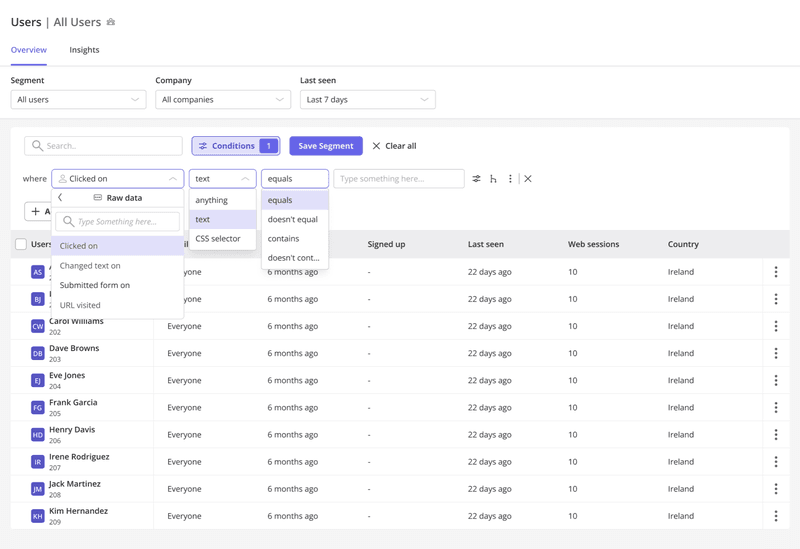
Key features
- Auto-capture. Automatically track any time a user clicks, enters a text, or fills a form on your platform. You can label the events you want to follow closely and use the user behavior tracking data to build in-app experiences.
- In-app guidance. Build and trigger unique flows, onboarding checklists, and tooltips by using the auto-captured information.
- User segmentation. Get detailed insights into how different groups of users behave. Use this information to build unique segments.
- Analytics reports. Visualize your data in trends, path, funnel, or retention (cohort) reports. This includes event-tracking data or auto-captured insights.
- Session replay (coming soon). Replay the video of a user’s in-app journey to see exactly what they do and why they behave in such a way. Identify friction points and get the qualitative feedback behind your hard data.
- Integrations. Userpilot integrates with other popular apps in your tech stack so you can share data about your tracked events for further action, e.g., send emails to a segment. This includes HubSpot, Google Analytics, Mixpanel, Amplitude, Google Tag Manager, Segment, Salesforce, and Intercom.
Suggested reading: Userpilot vs Mixpanel comparison
Pricing
Userpilot’s pricing follows a transparent structure. It has three available plans:
- Starter plan. Costs $299/month, billed annually. This is Userpilot’s entry-level plan for small companies and startups with up to 2,000 monthly active users (MAU). It supports three seats and limited product analytics.
- Growth plan. Custom priced. This is our most popular plan for mid-sized businesses. It supports retroactive auto-capture and unlimited product analytics and surveys. With this plan, you also get instant access to advanced event-based triggers and content localization.
- Enterprise plan. Custom priced. This plan helps large, enterprise-level businesses to auto-capture their users’ behavior, reach them at the right times, and analyze data in more detail. It also matches enterprise-level security requirements, such as SAML SSO and security audits, and compliance.

2. Google Analytics: Best for website and conversion tracking
Google Analytics is a digital analytics tool that tracks and reports website traffic and user behavior. This user tracking tool is designed for website owners, digital marketers, and analysts who need to understand how users interact with their sites.
While you can monitor clicks and behavior flows in Google Analytics 4 (GA4), the insights aren’t very detailed. So, to get the most out of GA4, you should install Google Tag Manager (GTM), as it allows you to add tags and track more detailed data about on-page user behavior.
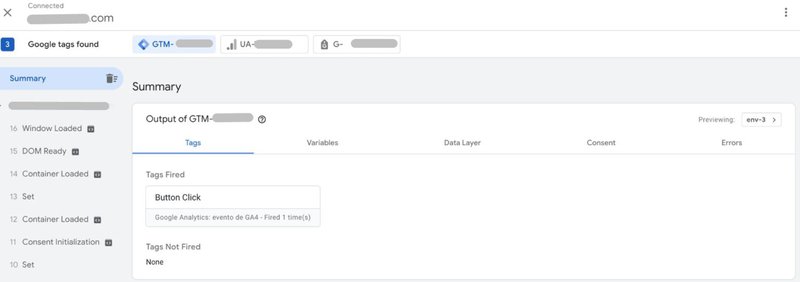
Key features
- Automatic event tracking. Automatically track user interactions on your site, such as clicks, downloads, or video plays.
- Custom click tracking. Like with other Google Analytics alternatives, you can create tags to track specific user clicks or behavior. For example, capture how many users click on your contact form.
- Conversion tracking. Define which of your automatic events or tags lead to conversions. This allows you to identify any friction points in your conversion path. You can also visualize how users move through your website on the GA4 path exploration report.
- Integrations. GA4 integrates with all Google products, including GTM. Plus, tools like Salesforce, Userpilot, Hotjar, Mixpanel, and Segment.
Suggested reading: Userpilot vs Google Analytics comparison
Pricing
Google Analytics offers two plans:
- Google Analytics 4 (GA4). Free for all Google users. This is the standard version and comes with robust tracking and reporting functionality. It’s suitable for most small to medium-sized businesses.
- Google Analytics 360. Custom priced. This is GA’s premium, enterprise-level version. It provides smart analytics, data freshness, BigQuery daily exports, dedicated support, and higher data limits.
3. Hotjar: Best for landing page tracking using heatmaps
Hotjar is a user feedback and product analytics tool that provides insights into how users interact with landing pages or websites through session recordings and heatmap tools. It’s designed for website owners, UX/UI designers, product managers, and marketers.
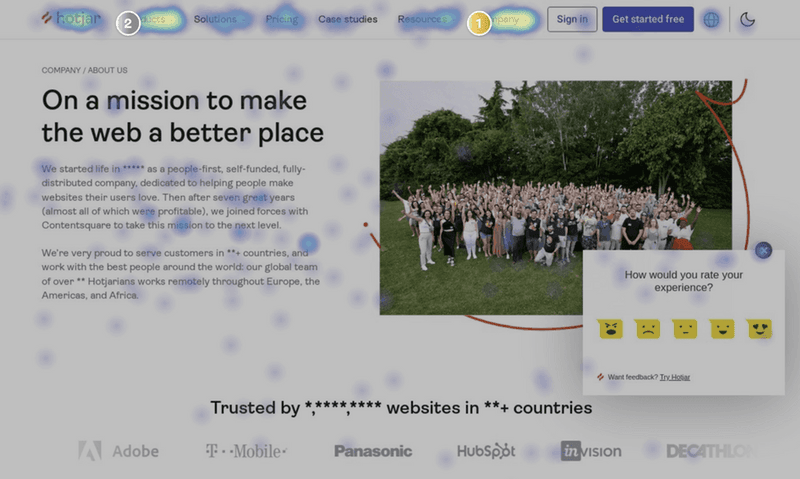
Key features
- Heatmaps. See visual representations of where users click, scroll, and hover on a page to understand which areas are the most popular or attention-grabbing.
- Session recording. Replay how users navigate through your site, including clicks, scrolls, and page interactions to visualize your users’ full on-page journey. It also lets you view usability issues and user behavior patterns.
- Trends. Explore your data analytics trends to combine your metrics with behavior patterns. This way, you can visualize how users interact with your on-page elements over time and if there’s any similarity in trends between segments.
- Integrations. Like other Hotjar alternatives, this tool connects with popular technology, such as Slack, Teams, GA4, Jira, HubSpot, and Google Tag Manager. This way, you can use your Hotjar information to get notified, set up the next steps, complete your analysis, or send personalized emails.
Suggested reading: Userpilot vs Hotjar comparison
Pricing
Hotjar pricing varies depending on your needs. The options include:
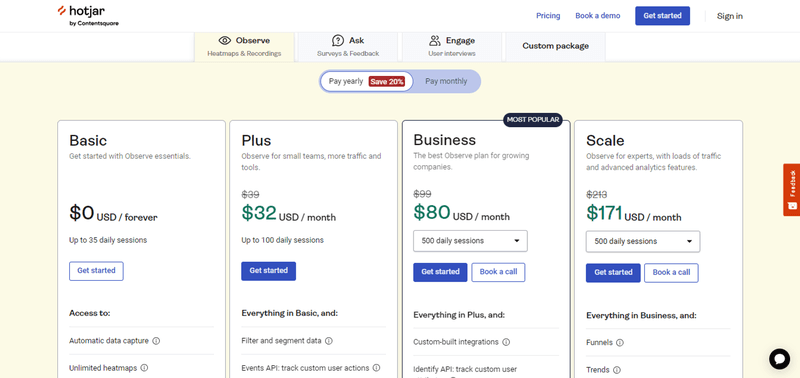
- Basic plan. Free. Includes core features like heatmaps, session recordings, and basic filters for up to 35 daily sessions. It’s suitable for small teams.
- Standard plan. $32/month*. Comes with unlimited feedback widgets and surveys. It supports 100 daily sessions. It’s also suitable for small teams.
- Business plan. $80/month*. Offers advanced filtering options, engagement heatmap zones, and frustration and engagement zones for 500 daily sessions. It’s suitable for growing companies as the number of daily sessions can expand for an additional price.
- Scale plan. $171/month*. Includes funnels, trends, console tracking, and SAML single-sign-on (SSO) security for 500 daily sessions (or more). It’s mostly suited for large companies.
*Billed annually.
4. Mixpanel: Best for advanced product analytics
Mixpanel is an analytics platform for tracking and analyzing user interactions to improve product performance.
Its detailed and visual access to product analytics allows product managers, data analysts, and marketers to understand user journeys in detail. It also enables them to take action and improve retention and user engagement.
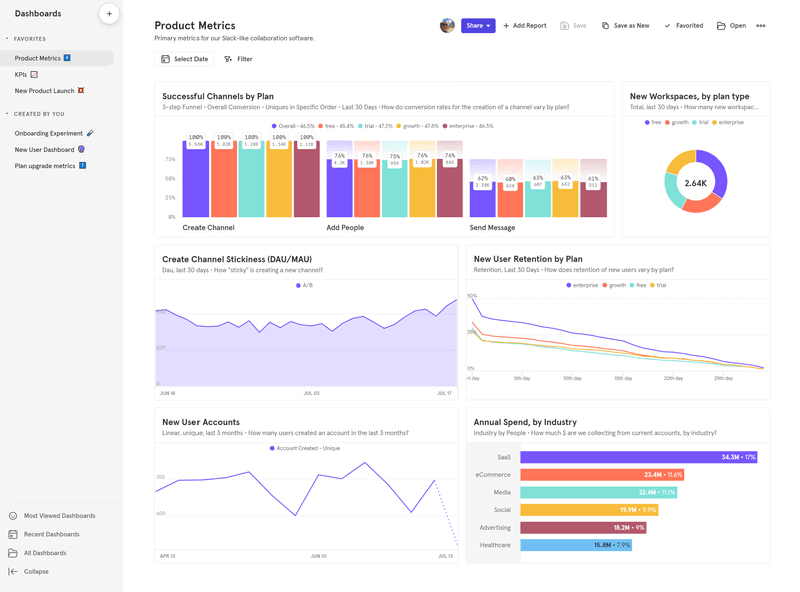
Key features
- Event tracking. Capture specific user actions or in-app events, such as clicks, sign-ups, or purchases. Define custom events to avoid tracking everything.
- Advanced product analytics. Access a detailed view of user analytics metrics and KPIs in customizable dashboards and reports. Create tailored views to monitor performance and track progress. You can see this data in a cohort analysis, insights reports, or funnel analysis.
- User profiles. Build and add user profiles to your events to discover who performed what. A user profile includes basic information such as name, email, and department so you can get access to individual user behaviors and journeys.
- Integrations. Mixpanel connects to multiple platforms, including Hotjar, Appcues, Google Ads, Slack, Intercom, and HubSpot. Depending on the tool, you’ll be able to export cohorts or events built on Mixpanel to other tools.
Suggested reading: Mixpanel vs Google Analytics
Pricing
Mixpanel pricing is feature – and usage-based, and it increases as you scale. This tool offers three plans:
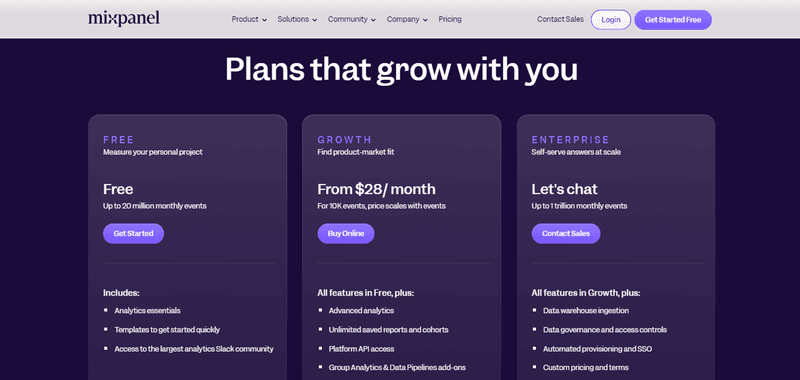
- Free plan. Includes essential analytics, up to 5 saved reports per seat, and limited behavioral cohorts. It’s ideal for personal projects.
- Growth plan. $28/month. Includes more advanced features like funnels, retention analysis, and flow reports. Pricing can scale with events. It’s ideal for mid to large businesses.
- Enterprise plan. Custom priced. Supports data warehouse ingestion, granular security, and up to 1T events. It’s suited for big and established products.
5. Crazy Egg: Best for visual website click tracking
Crazy Egg is a web analytics and conversion rate optimization (CRO) tool for traffic analysis and A/B testing. It provides insights into user behavior on websites through heatmaps, scrollmaps, and user recordings.
This digital analytics tool is designed for website owners, UX/UI designers, and marketers.
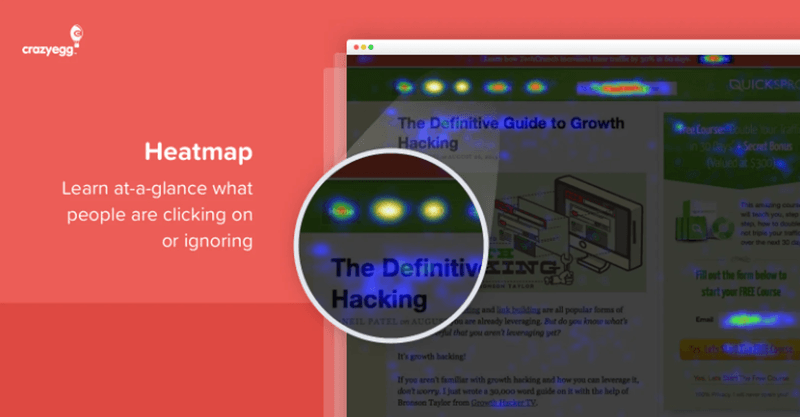
Key features
- Heatmap report. Visualize where users click, scroll, and hover on a webpage. A heatmap analysis helps you identify which areas of a page attract the most attention and which are ignored.
- Confetti report. This form of performance reporting gives you a breakdown of clicks by referral sources. It helps you understand where users come from and how the different traffic sources interact with your site.
- Overlay report. Discover the percentage breakdown of interactions on your webpage elements by displaying click counts overlaid on the page, e.g., identify which CTAs are the most popular.
- List report. This is a numerical report that shows how many clicks you got on a webpage element. It’s useful to make quick decisions, such as choosing which elements to cut or rewrite.
Pricing
Crazy Egg offers a 30-day free trial for any of these versions:
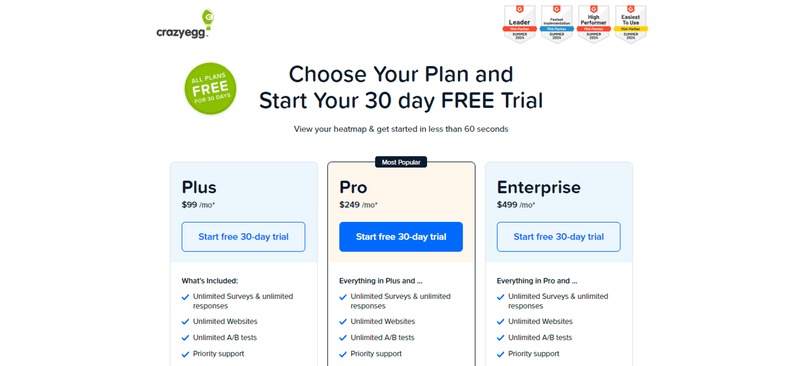
- Plus. $99/month. Comes with unlimited surveys and responses, websites, and A/B tests. This is mostly suited for growing websites.
- Pro. $249/month. Includes everything in Plus and 500,000 tracked page views, 100 snapshots, and 5,000 recordings per month. It’s suited for mid to large businesses with steady website traffic.
- Enterprise. $499/month. Supports everything in Pro and 1,000,000 tracked page views, 200 snapshots, and 10,000 recordings per month. Plus, SAML SSO.
6. Fullstory: Best for website and mobile click tracking
Fullstory is a product analytics software that offers deep insights into how users interact on your website or mobile app. It does this through session replay, heatmaps, and user journey analysis. This powerful tool is mostly designed for product managers, UX/UI designers, and data analysts.
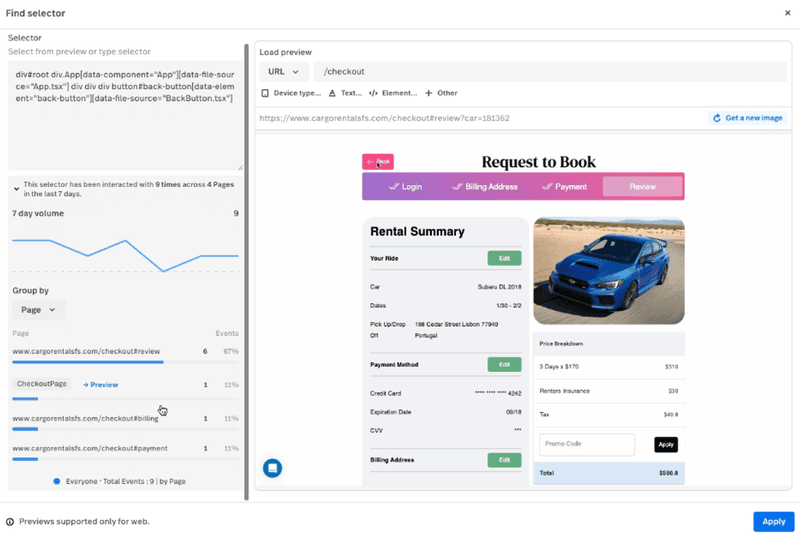
Key features
- Heatmaps. See where your users click or hover over your site. A heatmap highlights areas of high and low engagement.
- Journey mapping. Create user journey maps and analyze the paths users take through your site or app. It helps you understand common navigation patterns and potential friction points.
- Funnels and conversion tracking. Review how your user progresses through defined stages of your funnel. Analyze drop-off points and identify how to optimize your conversion paths.
- Integrations. Fullstory connects to multiple platforms and offers an open API for you to build integrations if needed. This tool connects to popular software, including Gainsight, GA4, Google Tag Manager, Intercom, Salesforce, Slack, and Zendesk.
Pricing
Fullstory comes at four price points, all with customized quotes:
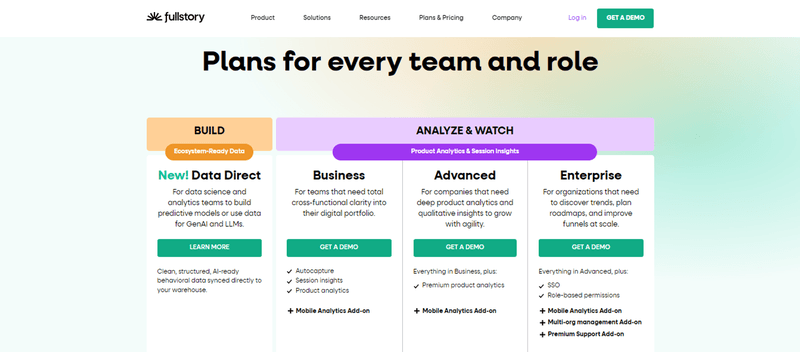
- Data direct. Offers clean, organized, and AI-ready user behavioral data that syncs to your warehouse. It’s suited for data science and analytics teams using AI and machine learning.
- Business. Supports auto-capture, session insights, and analytics for web and mobile apps. It’s designed for teams with a digital portfolio looking for cross-functional clarity.
- Advanced. Comes with everything in Business, plus premium analytics. It’s mostly for companies with deep product analytics needs.
- Enterprise. Supports everything in Advanced, plus SSO and granular security. It’s for large businesses that need to identify trends and improve funnels.
7. Mailchimp: Best for email click tracking
Mailchimp is an email marketing automation software for sending email campaigns, building segmented lists, and suggesting automated recommendations.
It’s suitable for marketers in businesses of all sizes and e-commerce sites looking to improve email marketing engagement and track campaign performance.
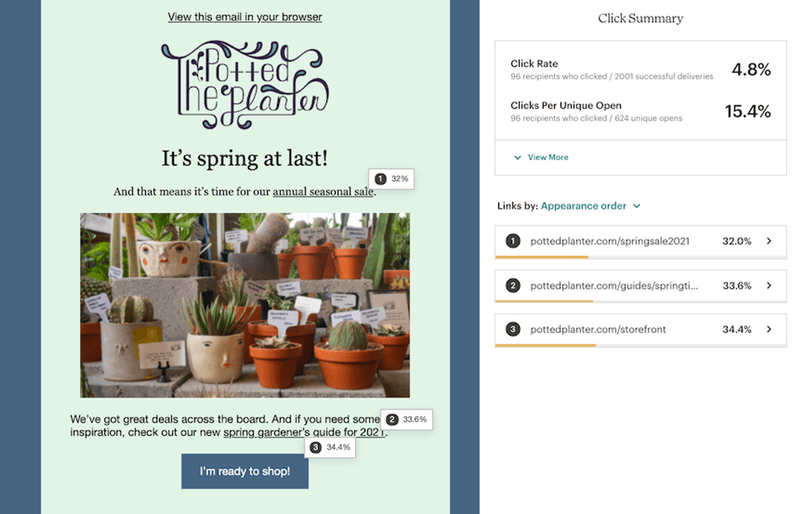
Key features
- Click tracking report. See which of your contacts clicked links in your targeted email campaign. View click rate, total clicks, clicks per link, last clicked, and click performance.
- Click map. Review where recipients clicked on in your email. This helps you understand user interaction patterns and the effectiveness of different elements in the email.
- Clicked activity. Get a list of all recipients who clicked on any tracked link within an email. This helps to understand who is engaged with your content. For instance, you could see who clicked on the resources you shared in the new user onboarding email.
- Integrations. Mailchimp integrates with popular tools such as Salesforce, HubSpot, Shopify, WooCommerce, and GA4. This way, you can export or import data from these platforms to build more targeted and contextual email marketing campaigns.
Pricing
Mailchimp offers four plans as an email marketing solution:
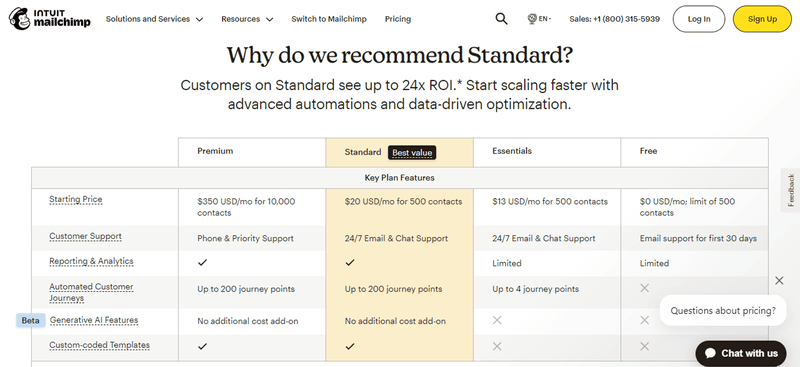
- Free plan. Offers basic features with a 500 contacts limit and reduced analytics. This is suited for freelancers and startups.
- Essential plan. $13/month. It has a 500 contacts limit but includes 24/7 email and chat support and lets you build up to 4 journey points. This plan is mostly for small and growing businesses.
- Standard plan. Starts at $20/month. This plan lets you modify the number of contacts you can import. It also includes up to 200 journey points and advanced analytics. Try this if you’re a mid or large business.
- Premium plan. Starts at $350/month. Comes with advanced features, including priority support, 10,000 contacts (or more), and analytics. Use this if you have a big contact base.
8. Unbounce: Best for landing page optimization
Unbounce is a landing page builder and optimization platform that allows marketers, agencies, and business owners to create and test high-converting pages without writing any code.
This platform also lets you A/B test and include pop-ups to drive conversions based on data and landing page best practices.
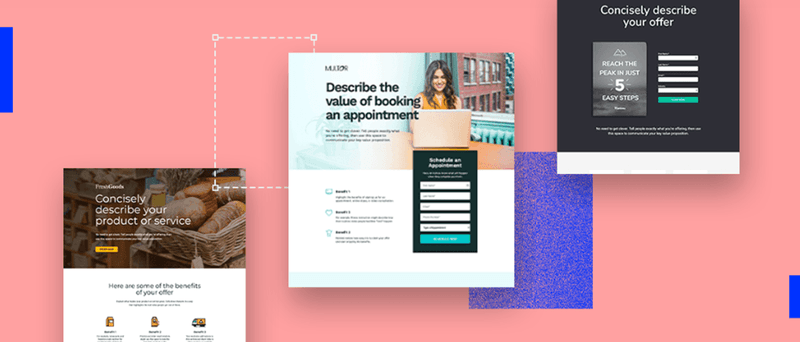
Key features
- Conversion optimization. Track the performance of your conversion rates, click-through rates, and engagement to optimize landing pages.
- A/B testing. Test how different versions of your landing page perform by making one variation. This allows you to choose the one with higher conversions.
- Real-time dashboard. Get access to an analytics dashboard to see how your pages perform and the results of your tests. To get more granular tracking, you’ll need to connect Unbounce to Google Analytics.
- Integrations. You can connect Unbounce to various CRM, email marketing, and analytics tools. These include Webhook, Zapier, Salesforce, HubSpot, Mailchimp, and Hotjar.
Pricing
Unbounce is available at four different price points:
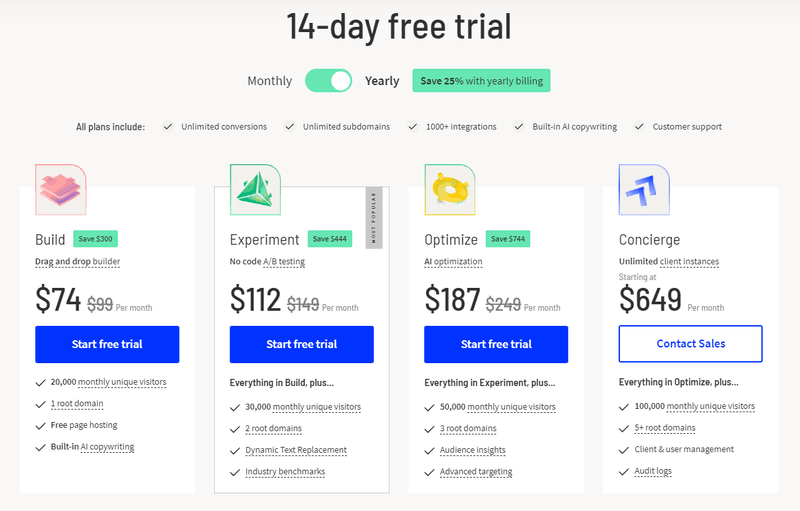
- Build. $74/month*. Includes AI copywriting and free page hosting. It’s for people who want to build their landing pages and connect them to one root domain.
- Experiment. $122/month*. Includes everything in Build, plus 30,000 monthly unique visitors, two root domains, benchmarks, and dynamic text replacement. It’s for people who want to experiment with A/B tests.
- Optimize. $187/month*. Includes everything in Experiment, plus 50,000 monthly unique visitors, three root domains, advanced targeting, and access to audience insights. It’s for users who want advanced AI optimization functionality.
- Concierge. Starts at $649/month. Includes everything in Optimize, plus 100,000 monthly unique visitors, more than five root domains, and audit logs. This plan is for agencies serving multiple clients.
*Billed annually.
9. ClickMagick: Best for ad and conversion optimization
ClickMagick is a link-tracking and optimization platform for paid ads and online marketing campaigns. This tool lets you track ads, social media activity, or emails for conversion rate optimization.
It’s suitable for digital marketers, affiliate marketers, and businesses looking to optimize advertising efforts.
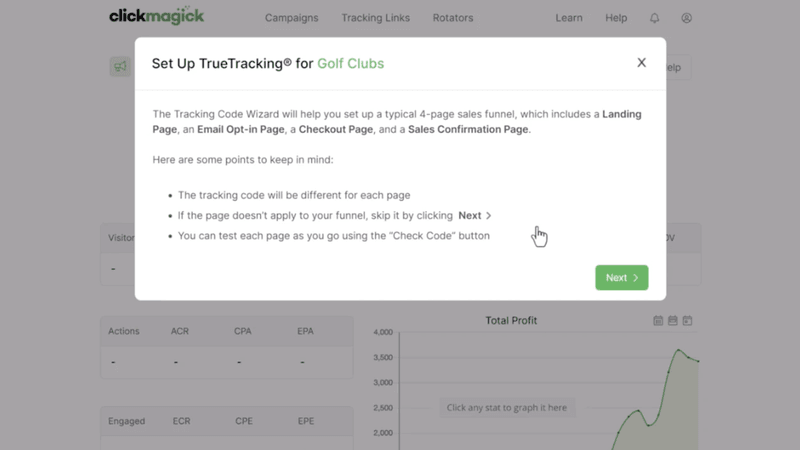
Key features
- Cross-device tracking. This customer tracking software lets you collect users’ behavioral data across the devices they own. This way, you can review individual user analytics despite where they accessed your ads.
- Advanced attribution modeling. Set rules to assign credit for sales and conversions across various touchpoints. ClickMagick allows you to define the last click, first click, linear, position-based, and time decay attributions.
- Ad optimization. Get more accurate conversion data to optimize your ads and networks through behavioral targeting. This lets you improve the performance of advertising campaigns.
- Integrations. ClickMagick integrates with various tools, including Google Ads, Facebook Ads, Google Analytics, and Zapier.
Pricing
ClickMagick is available at three price points:
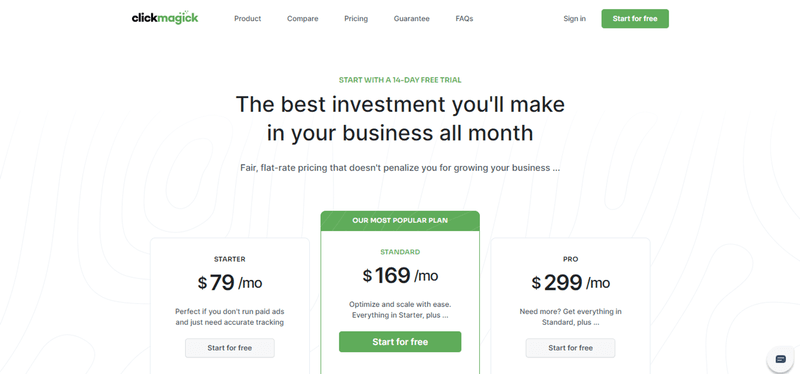
- Starter plan. $79/month. Allows up to 10,000 clicks a month, real-time stats and reports, one website, and one team member. It’s perfect for teams analyzing ad performance but not running them.
- Standard plan. $169/month. Everything in Starter, plus up to 100,000 clicks a month, five websites or stores, and three team members. It’s for growing teams.
- Pro plan. $299/month. Everything in Standard, plus up to 1,000,000 clicks a month and unlimited websites and team members. It’s ideal for agencies working with multiple clients at the same time.
Conclusion
Each click tracking software serves different purposes, so if you want to optimize landing pages with A/B testing, Unbounce is a strong choice. But if you want to view landing page session replays and heatmaps, Hotjar might do it for you. And, if you need to track email campaign behavior, look into Mailchimp.
And, for those who need an all-in-one solution for in-app user behavior tracking and product analytics, Userpilot is the only tool you need. Here, you’ll access features like autocapture, in-app product experiences, user segmentation, and detailed analytics. Want to try it for yourself? Get a demo.






